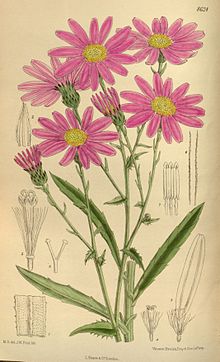| Senecio glastifolius | |
|---|---|

| |
| Scientific classification | |
| Kingdom: | Plantae |
| Clade: | Tracheophytes |
| Clade: | Angiosperms |
| Clade: | Eudicots |
| Clade: | Asterids |
| Order: | Asterales |
| Family: | Asteraceae |
| Genus: | Senecio |
| Species: | S. glastifolius |
| Binomial name | |
| Senecio glastifolius L.f. (1782) | |
| Synonyms | |
| |
Senecio glastifolius is a species of flowering plant in the aster family known by the common names woad-leaved ragwort, holly-leaved senecio, and pink ragwort. A tall perennial herb, it is endemic to the Cape Provinces of South Africa, and it is cultivated as an ornamental plant for its colorful flowers. It has been known to escape cultivation and become naturalized in areas of appropriate climate; it can be found growing wild in parts of New Zealand and Australia.
It favours a Mediterranean climate, often coastal, typically colonizing disturbed soil. It is an annual herb producing a single, erect, branching stem which grows to a height 1 to 1.5 metres tall. The serrated leaves are often more coarsely toothed near the leaf base, and feel prickly. The inflorescence bears flower heads lined with black-tipped bracts. They contain a yellowish disc at the centre, with mauve petals. Senecio glastifolius is sometimes confused with Senecio elegans, (which also grows by the coast), but the leaves of the two species are different.


References
- ^ Senecio glastifolius L.f. Plants of the World Online. Retrieved 9 October 2023.
- BSBI List 2007 (xls). Botanical Society of Britain and Ireland. Archived from the original (xls) on 2015-06-26. Retrieved 2014-10-17.
- P.A. Williams (1999). "Biology and ecology of Senecio glastifolius and its spread and impacts in New Zealand" (PDF). Science for conservation 112. Department of Conservation. Retrieved 24 Jul 2013.
- "Weed management guide - Holly leaved senecio (Senecio glastifolius)" (PDF). Department of the Environment and Heritage. Retrieved 24 Jul 2013.
External links
Senecio glastifolius description from New Zealand Plant Conservation Network
This Senecioneae-related article is a stub. You can help Misplaced Pages by expanding it. |